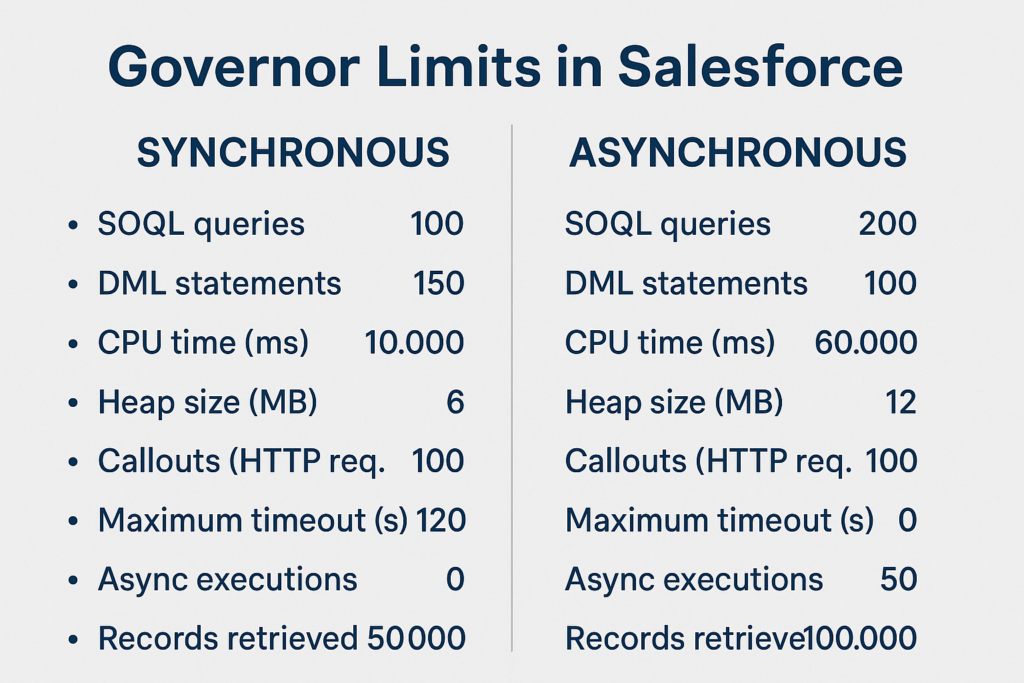Governor Limits in Salesforce – Synchronous vs Asynchronous
Introduction
Salesforce applies different limits depending on whether the Apex code runs synchronously (real-time, e.g., trigger, class) or asynchronously (delayed execution, e.g., Future, Queueable, Batch, Schedulable).
Key Difference
Synchronous Apex → Runs in real-time, user waits for response (e.g., triggers, VF controllers).
Asynchronous Apex → Runs in background, user doesn’t wait (e.g., @future methods, Batch Apex, Queueable).
Governor Limits Comparison Table
| Limit | Synchronous Apex | Asynchronous Apex (Future, Queueable, Batch, Schedulable) |
| Total SOQL Queries | 100 | 200 |
| Records retrieved by SOQL (per transaction) | 50,000 | 50,000 |
| Records retrieved by Database.getQueryLocator | 50,000 | 50 million |
| Total DML Statements | 150 | 150 |
| Records processed by DML (per transaction) | 10,000 | 10,000 |
| Maximum CPU time | 10,000 ms (10 sec) | 60,000 ms (60 sec) |
| Heap Size | 6 MB | 12 MB |
| Future method calls | 50 | 50 |
| Queueable jobs added to queue | 50 | 50 |
| Batch Apex – Records processed | N/A | 50 million |
| Batch Apex – Batch size | N/A | Up to 2,000 records per batch |
| Email (sendEmail methods) | 10 | 10 |
| Callouts (HTTP/Web Service) | 100 | 100 |
Explanation of Differences
- SOQL Queries (100 vs 200): In asynchronous execution, Salesforce allows 200 SOQL queries since background jobs often deal with bulk data.
- getQueryLocator (50k vs 50M): In synchronous code, you can only fetch 50,000 records at once. In asynchronous (like Batch Apex), you can handle 50 million records.
- CPU Time (10s vs 60s): Synchronous code must finish quickly for user experience → 10 seconds. Asynchronous gets 60 seconds since it runs in the background.
- Heap Size (6 MB vs 12 MB): Heap size (memory your code consumes) is doubled in async to allow handling larger data sets.
Best Practices
- Use Synchronous Apex for real-time operations (validations, before/after triggers).
- Use Asynchronous Apex for large data processing (batch jobs, integrations, heavy calculations).
- Always bulkify code to respect both synchronous & async limits.
- Use Queueable Apex or Batch Apex when you expect large record volumes.
Example
Imagine you want to process 1 million records:
- Synchronous Trigger/Class → Will hit SOQL (100) or CPU (10 sec) limits.
- Batch Apex (Async) → Can process up to 50 million records safely.
Conclusion
Synchronous Limits are stricter (smaller SOQL, CPU, Heap).
Asynchronous Limits are relaxed because Salesforce expects bulk & heavy operations there.
Choosing the right execution model is key to avoiding governor limit errors.

